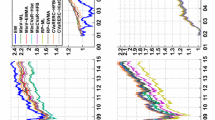Abstract
We provide a two-stage portfolio selection procedure in order to increase the diversification benefits in a bear market. By exploiting tail dependence-based risky measures, a cluster analysis is carried out for discerning between assets with the same performance in risky scenarios. Then, the portfolio composition is determined by fixing a number of assets and by selecting only one item from each cluster. Empirical calculations on the EURO STOXX 50 prove that investing on selected assets in trouble periods may improve the performance of risk-averse investors.
Access this chapter
Tax calculation will be finalised at checkout
Purchases are for personal use only
Similar content being viewed by others
References
Coppi R, D’Urso P, Giordani P (2006) Fuzzy \(C\)-Medoids clustering models for time-varying data. In: Bouchon-Meunier B, Coletti G, Yager R (eds) Modern information processing: from theory to applications. Elsevier Science, Amsterdam, pp 195–206
De Luca G, Zuccolotto P (2011) A tail dependence-based dissimilarity measure for financial time series clustering. Adv Data Anal Classif 5(4):323–340
De Luca G, Zuccolotto P (2015) Dynamic tail dependence clustering of financial time series. Stat Pap. doi:10.1007/s00362-015-0718-7
Dobrić J, Frahm G, Schmid F (2013) Dependence of stock returns in bull and bear markets. Depend Model 1:94–110
Durante F, Jaworski P (2010) Spatial contagion between financial markets: a copula-based approach. Appl Stoch Models Bus Ind 26(5):551–564
Durante F, Pappadà R, Torelli N (2014) Clustering of financial time series in risky scenarios. Adv Data Anal Classif 8:359–376
Durante F, Pappadà R, Torelli N (2015) Clustering of time series via non-parametric tail dependence estimation. Stat Pap 56(3):701–721
D’Urso P (2015) Fuzzy clustering. In: Meila M, Murtagh F, Rocci R (eds) Handbook of Cluster Analysis. Hennig C. Chapman & Hall,
Haerdle W, Nasekin S, Chuen D, Fai P (2014) TEDAS—Tail Event Driven ASset Allocation. Sfb 649 discussion papers, Sonderforschungsbereich 649, Humboldt University, Berlin, Germany, http://sfb649.wiwi.hu-berlin.de/papers/pdf/SFB649DP2014-032.pdf
Haerdle W, Chuen D, Nasekin S, Ni X, Petukhina A (2015) Tail event driven ASset allocation: evidence from equity and mutual funds’ markets. Sfb 649 discussion papers, Sonderforschungsbereich 649, Humboldt University, Berlin, Germany, http://sfb649.wiwi.hu-berlin.de/papers/pdf/SFB649DP2015-045.pdf
Hastie T, Tibshirani R, Friedman J (2009) The elements of statistical learning, data mining, inference, and prediction, Springer Series in Statistics, 2nd edn. Springer, New York
Kaufman L, Rousseeuw P (1990) Finding groups in data. Applied probability and statistics. Wiley Series in probability and mathematical statistics. John Wiley & Sons Inc., New York
Mantegna R (1999) Hierarchical structure in financial markets. Euro Phys J B 11(1):193–197
Patton AJ (2013) Copula methods for forecasting multivariate time series. In: Elliott G, Timmermann A (eds) Handbook of economic forecasting, vol 2. Elsevier, Oxford, pp 899–960
Rockafellar RT, Uryasev S (2000) Optimization of conditional value-at-risk. J Risk 2:21–41
Acknowledgments
The first author acknowledges the support of the Major Program of the National Social Science Foundation of China (No. 15ZDA017), and the support of Jilin University via the “Fundamental Research Funds for the Central Universities” (No. 450060522110) and via “Young Academic Leaders Training Program” (No. 2015FRLX07). The second author acknowledges the support of the Department of Economics, Business, Mathematics and Statistics “Bruno De Finetti” (University of Trieste, Italy), via the project “FRA”. The third and fourth author acknowledge the support of the Faculty of Economics and Management (Free University of Bozen-Bolzano, Italy), via the project “COCCO”.
Author information
Authors and Affiliations
Corresponding author
Editor information
Editors and Affiliations
Rights and permissions
Copyright information
© 2017 Springer International Publishing Switzerland
About this paper
Cite this paper
Wang, H., Pappadà, R., Durante, F., Foscolo, E. (2017). A Portfolio Diversification Strategy via Tail Dependence Clustering. In: Ferraro, M., et al. Soft Methods for Data Science. SMPS 2016. Advances in Intelligent Systems and Computing, vol 456. Springer, Cham. https://doi.org/10.1007/978-3-319-42972-4_63
Download citation
DOI: https://doi.org/10.1007/978-3-319-42972-4_63
Published:
Publisher Name: Springer, Cham
Print ISBN: 978-3-319-42971-7
Online ISBN: 978-3-319-42972-4
eBook Packages: EngineeringEngineering (R0)




